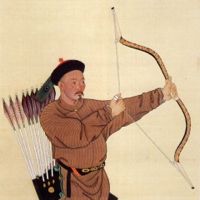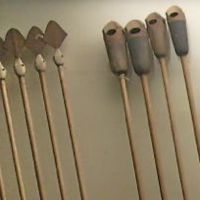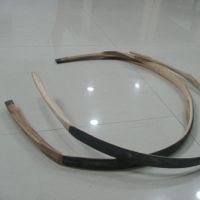Based on Lukas Novotny’s presentation at the archery seminar in Ledu, Qinghai, People’s Republic of China, 2012.
Written by Peter Dekker
Introduction
A traditional composite bow is almost like a living thing, it reacts on weather conditions and develops habits of its own. Nowadays there is a lot of information circulating about the making of traditional composite bows, and more and more people are starting to build them. But the making of a composite bow is only just one side of it, after it’s made it needs to be “taught” how to shoot by the archer. This stage of a bow’s life is crucial, but little information is available about proper bow maintenance and aftercare. This presentation is intended to provide some tips for composite bow builders as well as owners or future buyers.
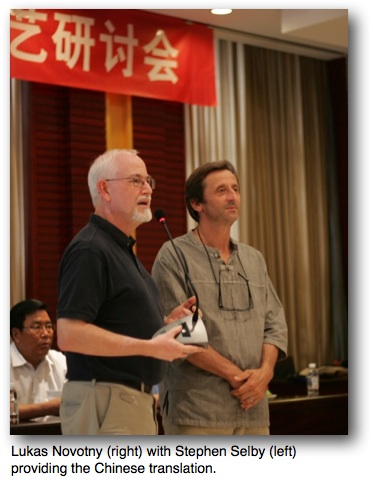
Preventing Twist
The biggest challenge with composite bows is their sensitivity to twist. A twisted limb may cause the bow to unstring and damage itself. In order to make a bow efficient, the ears and knees need to be reduced towards the minimum necessary to take the load. Where overbuild bows are slower and more foolproof, good high performance bows are more fragile because they can only take force in one direction. A slight twist can therefore have big consequences, especially so with bows with strongly recurved tips like the Korean traditional bow or those with long, recurved ears such as the Manchu bow.
Preventing twist starts at the building process. First, pay much attention to every detail in the core, the foundation of the bow. Make sure everything is perfectly straight and that the ears are spliced in straight. Any discrepancy at this stage will compromise the straightness of the bow. Second is the horn. Carefully select a piece of horn that has no cracks from drying. Clean the horn thoroughly before using it. Don’t use “green” horn, always use horn that is seasoned for a while, like wood. Make sure when you grind it, you grind it straight and evenly as to not cause the material to want to twist when bending. Preferably use horn from the same pair, or otherwise select horn with identical curvature. It is very important to put the horn through a flex test before adding it to the core. Due to different densities in different parts of the natural materials, a perfectly shaped slab of horn may still want to twist while being bent. If so, remove some material from the stiffest side until it flexes without twisting.
Sinewing
Apply the sinew in an environment that is as hot and humid as possible. This slows down the gelling of the glue so one has plenty of time to arrange it properly. Do not add the sinew as if throwing spaghetti to a wall! Make sure you use clean sinew with all the fat removed. Use a comb to comb the fibers, saturate the sinew with glue, and make sure the glue is of the right consistency.
Drying time
There are many myths circulating on bow drying times. In dry conditions the bow is ready to string in about 3-4 weeks. Lukas prefers to string them after about 6 months, but has found no notable differences in poundage from bows he cured for a month, half a year, or even over a year. When learning the craft, don’t aim for making a masterpiece bow the first time over. It is alright to string it and see how you have done after already a month or so. This speeds up the learning process considerably.
Learning with the bow
Once the bow is finished its working life begins. A good composite bow needs to “age like wine”, to get taught the proper habits of shooting. The first three months are crucial, in this period the bow will get set in its habit and it is important to teach it the right way to bend. Bowyers generally don’t have the time to shoot a bow in for three months so this part is up to the bow owner. Bows that develop a tendency to twist need to be corrected in this period, when done correctly the bow may be taught not to twist anymore. A well-maintained bow was said to last twice a man’s life, about 120 years. Bows used at the festival that were over 150 years old prove that this is in fact true. The worst thing for a traditional composite bow is neglect. It needs to be shot regularly, cared for, and properly corrected as soon as a misalignment arises.
“Bracing may be accomplished in many ways and diverse fashions. Some authors asserted that it could be done in no less than a hundred ways, while abu-Ja’far Muhammad ibn-al-Hasan al-Harawi placed the number at one hundred and twenty and described them in a book which he wrote for that purpose. Most of them, however, are repetitious and useless.”
-Unknown author, 1500’s.1
1Nabih Amin Faris & Robert Potter Elmer, Arab Archery, An Arabic Manuscript Of About A.D. 1500: A Book On The Excellence Of The Bow And Arrow And The Description Thereof. Princeton, Princeton University Press, 1945. P 21.
Stringing
However numerous methods there are for stringing, two methods are considered by most cultures to be the best way of stringing a composite bow without the need for extra tools such as bending blocks (Turkish: tepeliks Mandarin: gong nazi) or a peg board. One is over the knees, another is the so-called "step-in method".
Stringing over the knees
This is the safest method to string a bow without accessories because using this method it is easiest to bend both ears evenly and towards the right direction. It requires two people, one to bend the bow and another to attach the string on the opposing ear:
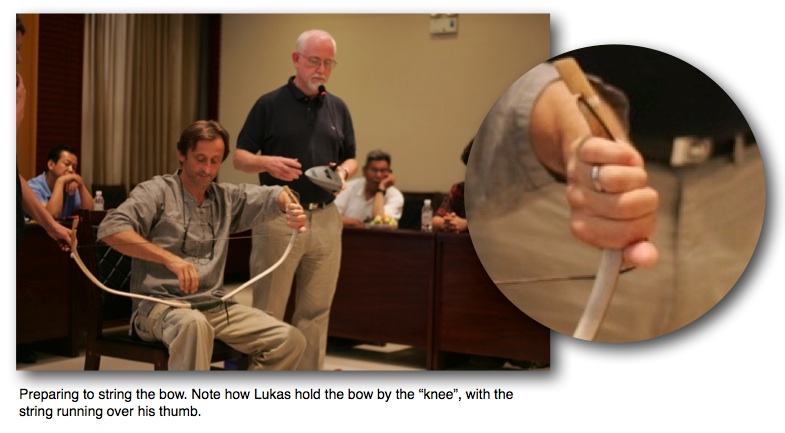
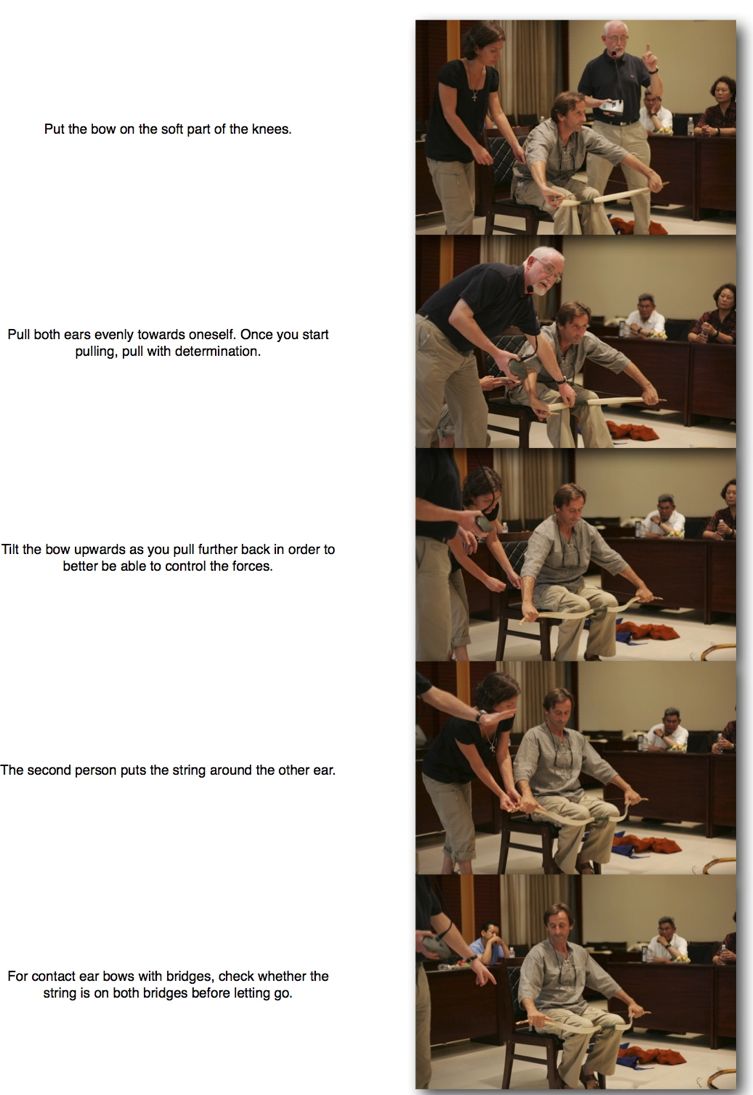
The step-in method
An advantage of this method is that one can do it alone. Some disadvantages are that the method is somewhat harder to do with long-eared bows and one is more likely to apply uneven force on the bow so it will come out strung unbalanced or twisted. It certainly requires some training to get right. In learning this method, it is best to begin using it as an unstringing method. Step into the strung bow and place its lower ear on the soft part of your shin. Put the handle against the back of your other upper leg. Press the upper ear forward to get the tension off the string, remove the string, and gently let the bow curve back into its relaxed state.
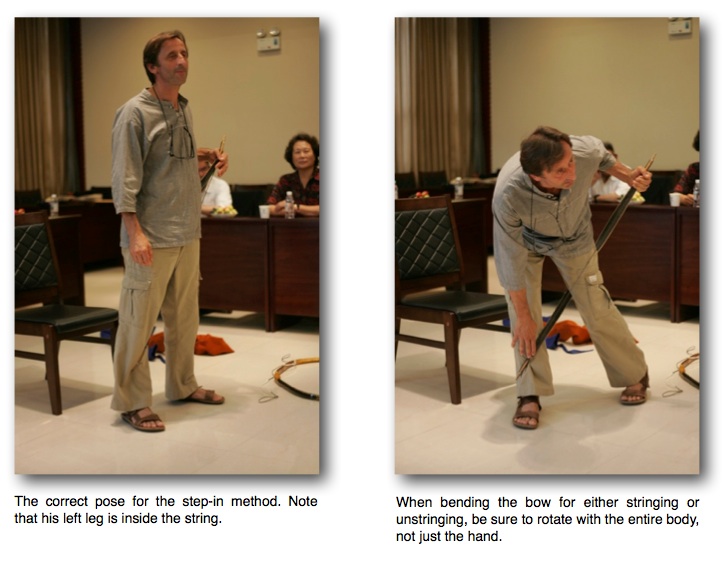
For unstringing large Manchu style bows, extra caution is advised using step-in methods. With the string removed the bow could twist quickly and the upper ear can slap the face or back of the head of the person unstringing. To prevent this, Manchu bows were unstrung with a slightly different method: Put the lower ear on your upper leg, grip the upper "knee" of the bow (the part between ear and limb), stretch that arm, and bend forward from the waist, pulling the upper limb forward as you bend. Remove the string from the lower ear and gently let the bow bend backwards. See this method illustrated in this old photograph:

Unknown photographer. Found on archerylibrary.com. They sent me this higher resolution image and gave kind permission to use it on this website. It was originally published in the article STRINGING THE CHINESE BOW by M.B. From the The Archer's Register for 1904-1905, pp. 279, Edited by H. Walrond. Came with the text: "The most difficult and capricious instrument of Archery is the Chinese Bow, the largest of the Central Asiatic type, and big brother of the Turkish Bow, which is the smallest of that type."
Correcting the bow
Once strung one has about a five-minute time window to correct the bow before it sets into its shape. First, check the balance of the bow. This is done by looking at the bow’s profile and seeing whether both limbs are about equally bent. With symmetrical bows it is common for the lower limb to be slightly stiffer, in other words, the lower limb bends a little less than the upper limb. To make a limb bend more or less for balancing, put the knee inside the belly of the limb that needs to be less stiff and bend it over the knee. The other limb will straighten out. Hold for about 30 seconds. If it does not give the desired effect, heat the limb that needs to be less stiff, bend it, and hold until it cools.
Once the bow is balanced look whether the ears are in alignment. The best way to see this is to look over the back of the bow at the ear as shown in the picture below. If twisted, correct it the other way by bending the ear in the opposite direction and holding it for about 30 seconds. If done right, it should settle in the middle. If not, keep correcting. This way you will “teach” the bow how to behave and when proper care is taken you won’t need to correct it anymore after a while. Bad twists can only be taken out with heat, and are best left to be corrected by an experienced bowyer. Twists at the handle are the most difficult to correct, and depending on their severity may not be correctable.
Once strung, let the bow stand for a few minutes before pulling it, as it needs some time to get used to its strung state. If you haven’t shot the bow for a while, give it half an hour instead.

Moist
Many sources say moist is a great problem for composite bows. According to Lukas’ experience these bows have no problems operating in moist conditions. The draw-weight may drop a little, but that’s about it. Moist and heat together may be more problematic. Be sure to keep the bow out of the bright sun whenever possible.
Conclusion
It takes a fine craftsman to build a proper traditional composite bow but equally importantly it takes a diligent archer to teach it how to behave the first three months and to nurture the character of the bow. Nowadays people are used to buying a product and whenever something is wrong with it, blame the manufacturer. In that sense buying a horn bow is more like raising a pet, or child, than buying a product. You give it the utmost care and learn along with it. In a while you will get to know the character of the bow, and what it needs to perform well and stay straight.
This article is written by me (Peter Dekker) based on the notes I made while attending a presentation by Lukas Novotny. While most of the information comes from Lukas Novotny, the article is not written in his words, but mine. Therefore any mistakes are my own. Published with permission of Lukas Novotny of Saluki Bow.
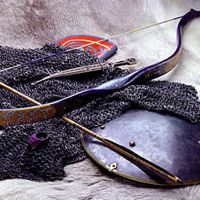
Saluki Bows website
Also see on our website:
Comments, questions? Discuss Manchu bows in our Facebook group:


